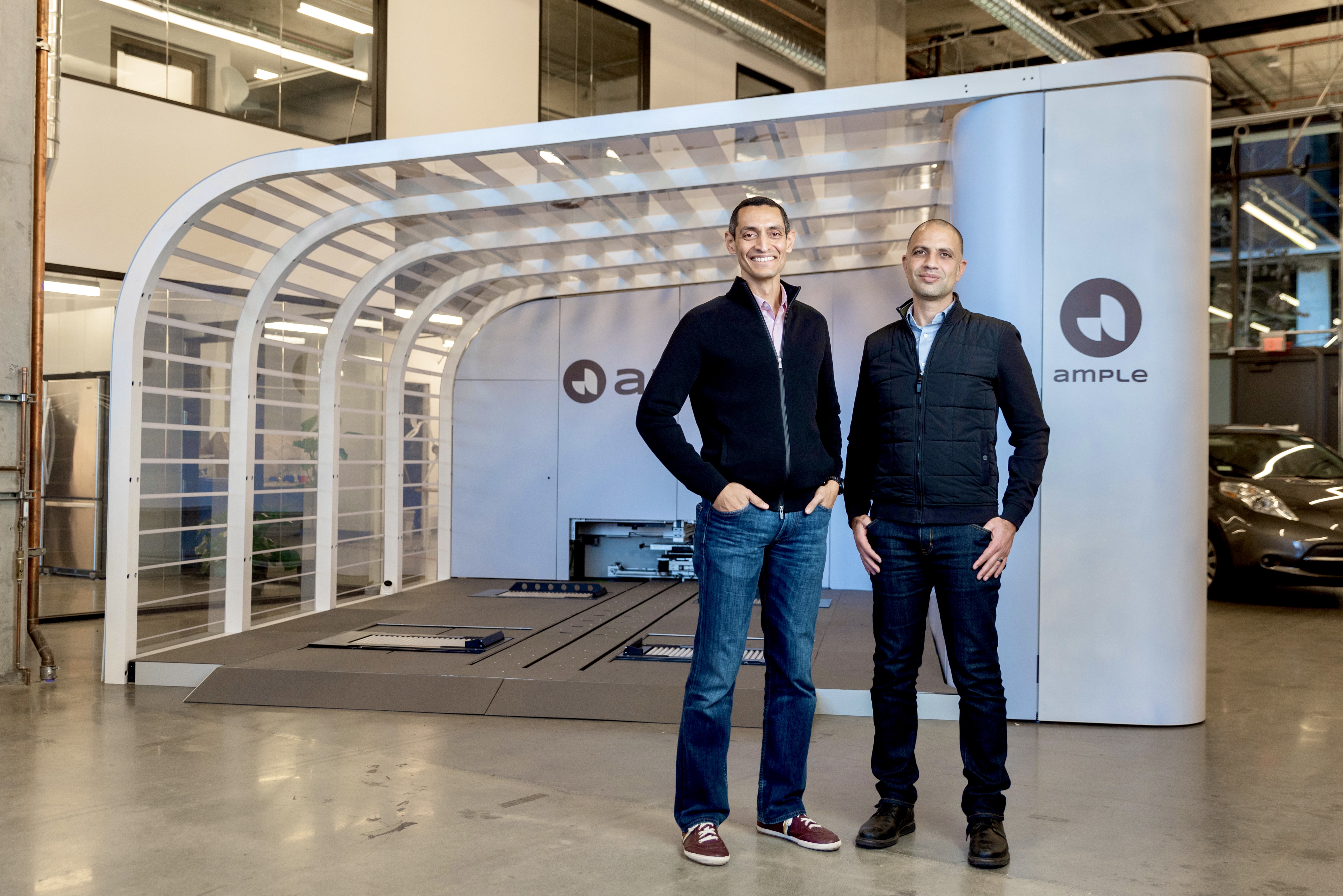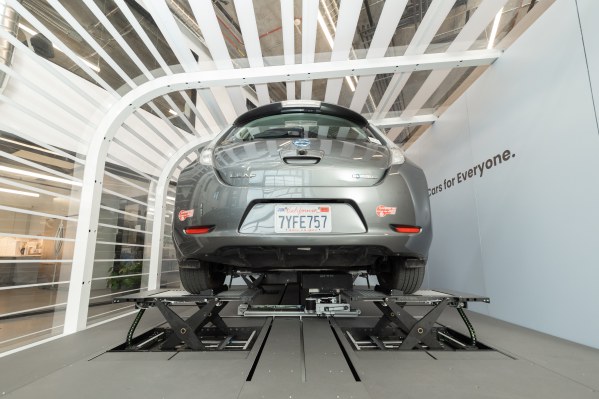A little over 13 years ago, Shai Agassi, a promising software executive who was in line to succeed the chief executive at SAP, then one of the world’s mightiest software companies, left the company he’d devoted the bulk of his professional career to and started a business called Better Place.
That startup promised to revolutionize the nascent electric vehicle market and make range anxiety a thing of the past. The company’s pitch? A network of automated battery swapping stations that would replace spent batteries with freshly charged ones.
Agassi’s company would go on to raise nearly $1 billion (back when that was considered a large sum of money) from some of the world’s top venture capital and growth equity firms. By 2013 it would be bankrupt and one of the many casualties of the first wave of cleantech investing.
Now serial entrepreneurs John de Souza and Khaled Hassounah are reviving the battery swapping business model with a startup called Ample and an approach that they say solves some of the problems that Better Place could never address at a time when the adoption of electric vehicles is creating a far larger addressable market.
In 2013, there were 220,000 electric vehicles on roads, according to data from Statista, a number which had grown to 4.8 million by 2019.
Ample has actually raised approximately $70 million from investors, including Shell Ventures, the Spanish energy company Repsol and the Moore Strategic Ventures, a venture firm that is the privately held investment firm of Louis M. Bacon, founder of the multibillion-dollar hedge fund, Moore Capital Management. That includes a $34 million investment first reported back in 2018, and a later round from investors including Japan’s energy and metals company, Eneos Holdings that closed recently.
“We had a lot of people that either said, I somehow was involved in that and was suffering from PTSD,” said de Souza, of the similarities between his business and Better Place. “The people who weren’t involved read up about it and then ran away.”
For Ample, the difference is in the modularization of the battery pack and how that changes the relationship with the automakers that would use the technology.
The approach we’ve taken… is to modularize the battery and then we have an adapter plate that is the structural element of the battery that has the same shape of the battery, same bolt pattern and same software interface. Even though we provide the same battery system… it’s the same as replacing the tire,” said Hassounah, Ample’s co-founder and chief executive. “Effectively we’re giving them the plate. We don’t modify the car whatsoever. You either put a fixed battery system or an Ample battery plate. We’re able to work with the OEMS where you can make the battery swappable for the use cases where this makes a lot of sense. Without really changing the same vehicle.”
Ample’s currently working with five different OEMs and has validated its approach to battery swapping with nine different car models. One of those OEMs also brings back memories of Better Place.
It’s clear that the company has a deal with Nissan for the Leaf thanks to the other partnership that Ample has announced with Uber. Ample’s founders declined to comment on any OEM relationships.
It’s clear that Ample is working with Nissan because Nissan is the company that inked a deal with Uber earlier this year on zero-emission mobility. And Uber is the first company to use Ample’s robotic charging stations at a few locations in the Bay Area, the company said. This work with Nissan echoes Better Place’s one partnership with Renault, another arm of the automaker, which proved to be the biggest deal for the older, doomed, battery swapping startup.
Ample says it only takes weeks to set up one of its charging pods at a facility and that the company’s charging drivers on energy delivered per mile. “We achieve economics that are 10% to 20% cheaper than gas. We are profitable on day one,” said Hassounah.
Uber is the first step. Ample is focused on fleets first and is in talks with multiple, undisclosed municipalities to get their cars added to the system. So far, Ample has done thousands of swaps, according to Hassounah, with just Uber drivers alone.
The cars can also be charged at traditional charging facilities, Hassounah said, and the company’s billing system knows the split between the amount of energy it delivers versus another charging outlet, Hassounah said.
“So far, in the use cases that we have, for ridesharing it’s individual drivers who pay,” said de Souza. With the five fleets that Ample expects to deploy with later this year the company expects to have the fleet managers and owners pay for charging.
Some of the inspiration for Ample came from Hassounah’s earlier experience working at One Laptop per Child, where he was forced to rethink assumptions about how the laptops would be used, the founder said.
“Initially I worked on the keyboard display and then quickly realized the challenge was in the field and developed a framework for creating infrastructure,” Hassounah said.
The problem was the initial design of the system did not take into account lack of access to power for laptops at children’s homes. So the initiative developed a charging unit for swapping batteries. Children would use their laptops over the course of the day and take them home, and when they needed a fresh charge, they would swap out the batteries.
“There are fleets that need this exact solution,” said de Souza. But there are advantages for individual car owners as well, he said. “The experience for the owner of a vehicle is after time the battery degrades. With ours as we put new batteries in the car can go further and further over time.”
Right now, OEMs are sending cars without batteries and Ample is just installing their charging system, said Hassounah, but as the number of vehicles using the system rises above 1,000, the company expects to send their plates to manufacturers, who can then have Ample install their own packs.
Currently, Ample only supports level one and level two charging, but won’t offer fast charging options for the car makers it works with — likely because that option would cannibalize the company’s business and potentially obviate the need for its swapping technology.
At issue is the time it takes to charge a car. Fast chargers still take between 20 and 30 minutes to charge up, but advances in technologies should drive that figure down. Even if fast charging ultimately becomes a better option, Ample’s founders say they view their business as an additive step to faster electric vehicle adoption.
“When you’re moving 1 billion cars, you need everything… We have so many cars we need to put on the road,” Hassounah said. “We think we need all solutions to solve the problem. As you think of fleet applications you need a solution that can match gas in charge and not speed. Fast charging is not available in mass. The challenge will not be can the battery be charged in five minutes. The cost of building chargers that can deliver that amount of power is prohibitive.”
Looking beyond charging, Ample sees opportunities in the grid power market as well, the two founders said.
“Time shift is built into our economics… that’s another way we can help,” said de Souza. “We use that as grid storage… we can do demand charge and now that the federal mandate is there to feed into the grid we can help stabilize the grid by feeding back energy. We don’t have a lot of stations to make a significant impact. As we scale up this year we will.”
Currently the company is operating at a storage capacity of tens of megawatts per hour, according to Hassounah.
“We can use the side storage to accelerate the development of swapping stations,” de Souza said. “You don’t have to invest an insane amount of money to put them in. We can finance the batteries in multiple ways as well as utilize other sources of financing.”

Ample co-founders John de Souza and Khaled Hassounah. Image Credit: Ample
Early Stage is the premier “how-to” event for startup entrepreneurs and investors. You’ll hear firsthand how some of the most successful founders and VCs build their businesses, raise money and manage their portfolios. We’ll cover every aspect of company building: Fundraising, recruiting, sales, legal, PR, marketing and brand building. Each session also has audience participation built-in — there’s ample time included in each for audience questions and discussion.
